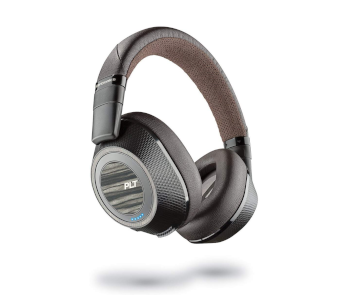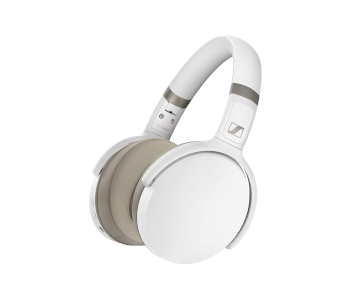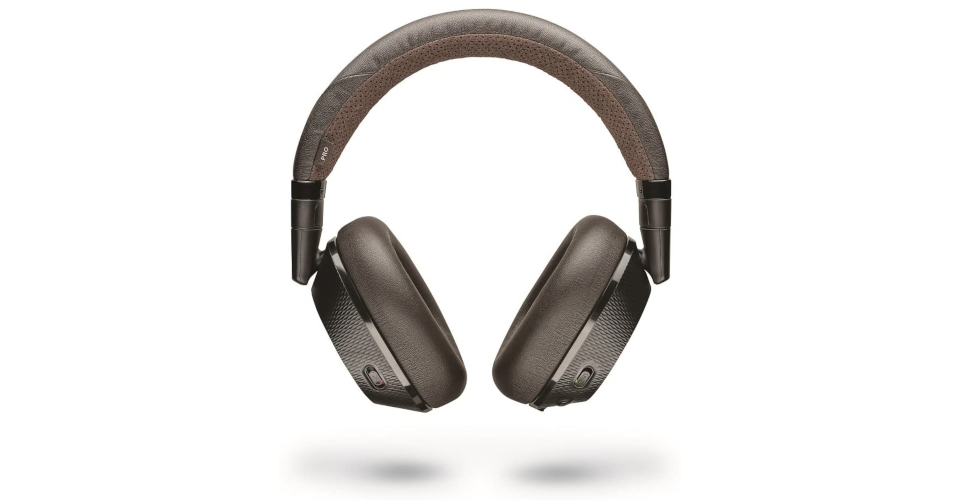Headphones Comparison: Plantronics BackBeat Pro 2 vs. Sennheiser HD 4.50BTNC
Wireless over-ear headphones with active noise cancellation (ANC) are generally more expensive than regular headphones, with some of the best ones selling for more than $200. But if you have a relatively more limited budget, there are also good options under $200.
The Plantronics BackBeat Pro 2 and the Sennheiser HD 4.50BTNC are two of the best noise-canceling over-ear headphones that you can get for less than $200. Both products can be bought for around $150 or less on some days and similarly offer good value for the money, but they have different strengths. In this head-to-head comparison article, we’ll highlight their individual strengths and weaknesses, along with their similarities.
Quick Look
| Plantronics BackBeat Pro 2 | Sennheiser HD 4.50BTNC | |
|---|---|---|
| Type | Wireless over-ear | Wireless over-ear |
| Enclosure | Closed-back | Closed-back |
| ANC | Yes | Yes |
| Connectivity | Bluetooth 4.0, 1/8 in (3.5 mm) analog | Bluetooth 4.0, 1/8 in (3.5 mm) analog |
| Battery | 24 hours | 19 hours |
| Weight | 10.2 oz | 8.4 oz |
| Price | Amazon | Amazon |
Design
Coming out on top in three of the five categories, the BackBeat Pro 2 are better-designed headphones than the HD 4.50BTNC. They have a more comfortable fit and a much better control scheme and are better-built overall. On the other hand, the Sennheiser headphones are more portable and easier to carry whether for traveling or for everyday use at the office. While they are inferior in overall comfort and build quality, they are lighter and have a more stable fit.
Fit
The BackBeat Pro 2 and the HD 4.50BTNC are both over-ear headphones with large ear cups that will easily accommodate most ear sizes. Both are decently breathable for closed-back headphones and have a secure fit, allowing them to stay firmly on your head. Their headbands are similarly padded for additional comfort. But while their general designs are similar, the Plantronics headphones are more comfortable overall.
Featuring oval ear cups, the BackBeat Pro 2 are more comfortable to use for extended listening, which is beneficial when using them during long flights and throughout typical work shifts. In addition to having a looser headband clamp, their headband padding is also more generous. On the other hand, they are heavier than the Sennheiser headphones, but not by a significant margin.
The HD 4.50BTNC are still some of the more comfortable over-ear headphones out there, with their lighter build being a big plus for some people. However, their tighter headband clamp is more fatiguing on the head during long listening sessions, especially if you have a large head. Their headband padding is also thinner than that of the Plantronics headphones, but it doesn’t affect the comfort as much as the tighter headband clamp.
On the plus side, the tighter fit of the HD 4.50BTNC allows them to stay more securely on your head when moving around. If you want a pair of over-ear headphones that are decent enough for jogging and light exercises, the Sennheiser headphones are the better pick between the two, with their lighter frame and better stability being the chief reasons. Their wireless design also means there is no audio cable that can get caught into something while exercising, but their less breathable design (compared to in-ear and open-back headphones) means you’ll sweat more than usual.
Build

Both headphones look and feel sturdy and durable, with their similarly metal-reinforced headbands allowing for a good amount of flexibility to accommodate most head shapes and sizes, but the BackBeat Pro 2 are better-built overall. They are sturdier and more premium-looking and have fewer moving parts that are vulnerable to wear and tear. Their more generously padded headband and memory foam earpads are covered with synthetic leather while their plastic parts feel robust.
While not on the same level as the Plantronics product, the HD 4.50BTNC are also well-built over-ear headphones that are primarily made of plastic. Their headband feels solid while their oval ear cups, which also have leatherette-covered cushions, are sturdy. However, their overall build is not as robust as that of the BackBeat Pro 2, not to mention their foldable design adds more moving parts that can turn into weak spots in the long run.
Regarding aesthetics, the two headphones are not as colorful and head-turning as Beats headphones and instead have relatively more discreet designs that some people will prefer for everyday use. Both are also available in two color variants, with one being a special edition. For the BackBeat Pro 2, the regular model has a black-and-tan color scheme while the special edition has a more appealing gray color scheme. For the HD 4.50BTNC, you can choose between the regular black-and-silver model and the all-black, Amazon-exclusive special edition, which is harder to find nowadays.
Controls
The BackBeat Pro 2 have a more complete, more efficient, and more user-friendly on-cup control scheme than the HD 4.50BTNC. They have a volume wheel and buttons for music management on the left ear cup, which are responsive and well-spaced, making them easy to use while on the go. In addition, there is a dedicated switch for toggling between ANC and ambient sound modes, with the option to disable the ANC altogether if you don’t need it.
On the right ear cup, there is a multi-function button on the backplate for activating your voice assistant and for call management. You also get a power switch for turning the headphones on or off and for manually initiating the Bluetooth pairing, along with a dedicated mic mute button, which is not usually seen in non-gaming headphones. With the mic mute button, you can easily disable the mic temporarily during a phone call.
Although it might seem daunting at first, the on-cup control scheme of the BackBeat Pro 2 is one of the best out there, beating out the touch-based controls of some high-end headphones not only in terms of functionality but also in ease of use. The headphones also have sensors that detect when you remove them from your head. They automatically pause the music when you take them off and resume once you put them back on your head, which is very convenient.
The on-cup controls of the HD 4.50BTNC are still decent and far from being the worst among wireless over-ear headphones, but they are more confusing and more cramped. You get a multi-function slider button for call and music management and for voice assistant activation, along with a power button and separate volume buttons – all of them are found on the right ear cup. The multi-function slider button is not very intuitive while the volume buttons are also used for toggling the ANC, but only in wireless mode; when in wired mode, the ANC toggle transfers over to the power button.
With most of the main functions confined to just two places – the multi-function slider button and the volume buttons – the on-cup controls of the HD 4.50BTNC are more difficult to use. Sennheiser certainly could have done a better job at distributing the controls on both ear cups. A separate button or switch for the ANC would have made a big difference, for example.
Portability
Unlike in the previous three categories, the HD 4.50BTNC have the upper hand in this specific category. Their ear cups are foldable, allowing them to have a smaller footprint and take up less space when stored in your bag. This makes them more travel-friendly and easier to carry for everyday use. They also come with a soft case for protecting them against dust and scratches, but not against major physical impact and water damage.
The BackBeat Pro 2, on the other hand, don’t fold into a more compact form, which hurts their overall portability and makes them less travel-friendly than the Sennheiser headphones. Their ear cups can swivel to a flat position, though. This makes them less cumbersome to wear around your neck when not in use and allows them to slide into your bag more easily. For storage, you get a soft pouch, but if you go for the more expensive special edition model, you get a hard case instead. Compared to a soft pouch or case, a hard case provides better protection against physical impact, but it has a larger footprint.
Both headphones are quite bulky and not as portable as earbuds and earphones, but if portability is very important to you, then the HD 4.50BTNC are the more appealing option. In addition to their foldable design, they are also lighter, but not by a significant margin, as the BackBeat Pro 2 are also relatively lightweight for over-ear headphones.
Accessories
The two headphones come with almost the same accessories, with the only difference being their storage types. The BackBeat Pro 2 include a micro USB charging cable, an audio cable, and a soft pouch. (As mentioned, the soft pouch gets upgraded to a hard case if you buy the special edition model of the headphones.) Meanwhile, the HD 4.50BTNC come with a micro USB charging cable, an audio cable, and a collapsible soft case. For both headphones, the included audio cable ends with a 1/8 in (3.5 mm) analog plug, which allows for easy compatibility with most mobile devices.
Performance
The BackBeat Pro 2 and the HD 4.50BTNC are about even in overall performance, with each product edging out the other in a similar number of aspects. The Plantronics headphones are better-sounding, with a more exciting sound profile, and have a longer battery life per charge. They also have a better wireless range and come with a companion app. Meanwhile, the Sennheiser headphones have better sound isolation and mic performance. Moreover, they support NFC technology on both the regular and special edition models and generally have lower latency.
Sound
Considering Sennheiser’s reputation, it’s easy to assume that the HD 4.50BTNC are the better-sounding headphones right off the bat. But in reality, the BackBeat Pro 2 are the better-sounding of the two, with an exciting sound profile that will please most consumers.
They have a better-balanced and more accurate mid-range and a more detailed treble. Their soundstage is also larger and more open, but it’s not on the same level as that of open-back headphones. On the other hand, their more bass-heavy sound may be unappealing for some people, especially since their bass can be overpowering sometimes. But if you mainly listen to electronic dance music and hip hop, you’ll certainly find their powerful bass appealing.
The HD 4.50BTNC are not exactly mediocre in the sound department. Some people will find them more pleasant due to their warmer sound. Their bass is more accurate than that of the Plantronics headphones while their mid-range performance is good. But their mid-range is less balanced while their treble is mediocre and has less detail, not to mention their soundstage is inferior.
For general media consumption, both headphones will satisfy most consumers. But for strictly listening to music, many people will find the BackBeat Pro 2 more appealing due to their more exciting sound profile. You can’t modify the sound of both headphones by normal means, as they lack a companion app with sound customization options, unlike some noise-canceling headphones like the Sony WH-1000XM3 and the Jabra Elite 85h.
Isolation

With their more effective noise cancellation, the HD 4.50BTNC are better at blocking out background noise than the BackBeat Pro 2. They are better at blocking out low-frequency noises and ambient chatter and are good at reducing high-frequency noises. Their sound leakage is also very low, which means you won’t disturb people around you when listening to music at high volume, especially in quiet environments.
The noise cancellation of the BackBeat Pro 2 is only decent at best, with their subpar performance at blocking out low-frequency noises being disappointing for noise-canceling headphones. They are quite decent at reducing background chatter and are just as good at blocking out high-frequency noises as the HD 4.50BTNC, but their noise isolation is weaker overall. Their sound leakage is also higher, but it’s not high enough to be a problem in quiet places.
On the plus side, the BackBeat Pro 2 have an easily toggled ambient sound mode, which can be enabled using the dedicated switch on the left ear cup. When enabled, ambient sound mode filters background noise in. This allows you to quickly monitor your environments without removing your headphones, which is convenient in some situations – like when listening to announcements in train stations and airports.
Both the BackBeat Pro 2 and the HD 4.50BTNC are good for commuting, traveling, and office use, especially considering their convenient wireless designs. But you need to have music playing to block out background noise more effectively, as both headphones are not on the same level as some of the best noise-canceling headphones such as the Bose QuietComfort 35 II and the Sony WH-1000XM3.
Mic
The HD 4.50BTNC have a better mic than the BackBeat Pro 2, which makes them more suitable for phone calls and video conferences. Their recording quality and capability to separate your voice from background noise in moderately noisy places are better. The Plantronics headphones are also decent at masking noise for better voice pick-up, but their recording quality is mediocre, which is disappointing since Plantronics is known for making good headsets.
Battery
Capable of running up to 24 hours per charge, the BackBeat Pro 2 have better battery life than the HD 4.50BTNC, which can only run up to 19 hours per charge. This makes them more suitable for very long flights, train rides, and road trips. They also have a power-saving feature in the form of an auto-off timer, which the Sennheiser headphones lack. On the other hand, they take longer to charge, with Plantronics listing a charging time of three hours.
The HD 4.50BTNC can also match the 24-hour battery life of the BackBeat Pro 2, but only when their noise cancellation is disabled. When only Bluetooth is enabled, they can run up to a solid 25 hours per charge – a full six hours longer than when ANC is turned on. In addition to their shorter battery life with Bluetooth and ANC enabled, they also lack power-saving features like an auto-off timer and an automatically triggered standby mode. Their officially listed two-hour charging time is better than that of the Plantronics headphones, though, which is a notable plus.
Both headphones can be used in wired mode. This means you can still use them as regular headphones when their batteries are depleted, which is especially beneficial if they run out of power in the middle of a flight or right before your commute back home from the office.
Connectivity
The BackBeat Pro 2 and the HD 4.50BTNC have similarities and individual strengths in this category. Both are equipped with Bluetooth 4.0, support multi-device pairing and Qualcomm aptX codecs, and come with an analog audio cable terminating in a 1/8 in (3.5 mm) plug. With their multi-device pairing features, you can connect them to two compatible devices at the same time and quickly switch between them.
That’s it for the similarities between the two headphones. Let’s move on to the individual strengths, starting with the Sennheiser product. Both the regular and special edition models of HD 4.50BTNC support NFC technology for faster pairing – the same technology is only available on the pricier special edition of the BackBeat Pro 2. Under normal circumstances, the HD 4.50BTNC also have lower latency when connected to computers and iOS and Android mobile devices.
On the other hand, the BackBeat Pro 2 boast a much better wireless range, with Plantronics advertising an impressive range of 330 feet. While their latency is normally higher than that of the HD 4.50BTNC, they support the aptX Low Latency (aptX-LL) codec. When paired with a Bluetooth transmitter that also supports the same codec, their latency is significantly lower and practically undetectable, which is especially useful if you want to use the headphones for gaming and watching TV.
In addition to their better wireless range and lower latency with aptX-LL, the BackBeat Pro 2 also come with a companion app, which is compatible with iOS and Android mobile devices. But this isn’t really a big advantage for the Plantronics camp, as the app doesn’t offer many customization options and is one of the more limited headphone apps out there.
Wrap-up
| Plantronics BackBeat Pro 2 | |
|---|---|
| The BackBeat Pro 2 are some of the most versatile headphones under $200 and are better all-around headphones than the HD 4.50BTNC. They are good for commuting, traveling, office use, gaming, and watching TV in either wired or wireless mode. They are better-built headphones with a much better on-cup control scheme, a more comfortable fit, a longer battery life per charge, and a more exciting sound profile. Their wireless range is also better than that of the Sennheiser headphones, and they support the aptX-LL codec for lower latency when paired with the right transmitter. While their noise cancellation is slightly disappointing, they are great headphones for all-around everyday use. | |
| Pros | Cons |
|
|
| Sennheiser HD 4.50BTNC | |
|---|---|
| If portability and noise isolation are the most important factors for you, then the HD 4.50BTNC are a better option than the BackBeat Pro 2. They are wireless headphones with a more effective ANC and a foldable design for better portability. Furthermore, their mic performance is better while their sound leakage is lower. They also support NFC technology, which is only available on the more expensive special edition of the Plantronics headphones. Overall, the HD 4.50BTNC are a solid pair of wireless headphones for everyday use, but their tighter fit is more fatiguing for extended listening while their on-cup controls are not the most user-friendly. | |
| Pros | Cons |
|
|

